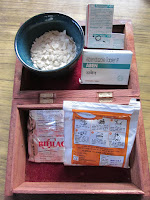November / December 2020
All the houses decked with brightly coloured lights, lots of candles and decorations. Special festival songs; kids going round the houses singing and asking for treats or money; preparing for a special visitor to come into your house – a visitor who somehow manages to visit every house on the same day and who appreciates certain treats that you leave out.
In October or November Nepal celebrates a beautiful festival called Tihar. Some things are similar to Diwali, the festival of lights which is celebrated in India, but the meanings behind it seem to be different. In my first experience, it certainly had the feeling of Christmas because of all the lights on the houses – but last year it was only October so it seemed far too early! Still, it’s the time to soak up the Christmas feeling of joy and celebration because when it comes to Christmas here, only a few Christian homes will have lights. There are five days to this festival, each worshipping a different animal or person – crows (seen as messengers of death) then dogs , cows, the goddess Laxmi and finally brothers. For crows, dogs and cows people give them food (even though every other day of the year crows and dogs might be shooed away) and people they give tikka (a red powder on the forehead for a blessing) to dogs, cows and brothers and put mallas (circles of flowers) round their necks.
This year somehow I noticed more comparisons with Christmas. Laxmi is the goddess of wealth so everyone wants to keep her happy and have her come into her homes – sounds a bit like telling kids to be good so that Santa will come to give lots of gifts and somehow visit every home in one night. To encourage Laxmi to come, this is the spring-cleaning season – people selling brushes do a good trade. After cleaning the house, people put strings of marigolds outside their homes or shops which stay there all year. At first they look very bright, before they’re covered in dust or dry up. Inside they have a display of fruits and nuts for Laxmi and make a special ring snack called Sel Roti, made out of rice flour and looks like a donut (they also get made for Christmas or any celebration). Outside the home there might be a mandala decoration made with coloured powder, and then a little trail with lights running all the way into the house to encourage Laxmi in. And these days, many houses have so many lights outside – hung down in vertical strings. Somehow they pop up almost overnight and disappear after only a week – unlike the month or more in the UK!
And along with lights there are some fireworks and firecrackers
– just a few, but enough give the feeling of Guy Fawkes night. And then, there’s the singing and
dancing! There are special songs used
during Tihar and traditionally people go round the homes singing them. This year I only saw one or two groups of
kids going round due to corona restrictions, but they were having fun and kept
singing and also making up songs hoping for money or sel roti or other
treats. Somehow it feels like a mixture
of Halloween trick or treat / guising plus the traditional carol singing when
they demanded Figgy pudding! I think
this song singing culture helps to explain why Nepal has a whole collection of
its own Christmas carols and people love to go round houses of Christians to
sing carols and then eat a feast in the run up to Christmas. I’m happy I got to join that craziness last
year as this year, unsurprisingly, we were not allowed to squeeze 50 people
into one small home, singing and dancing away.
So there you have it, the Nepali Tihar which feels like two
or three British festivals rolled into one!
You even can see the influence of Tihar decorations in how people celebrated
16 days of Activism against Gender-Based Violence in November and December this
year, through UMN’s work: www.umn.org.np/news/915









